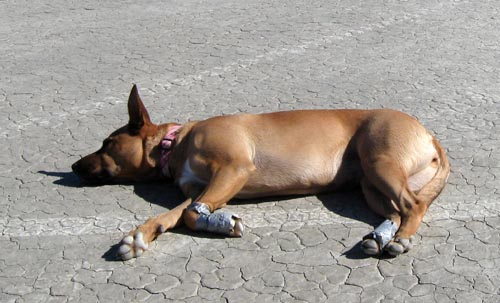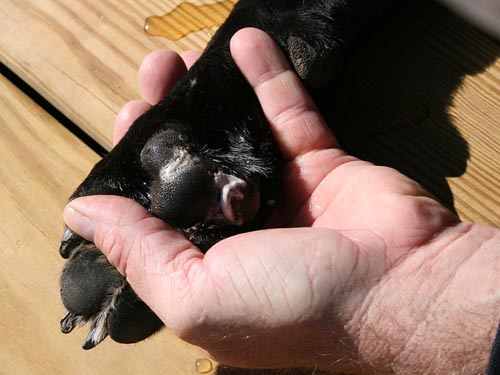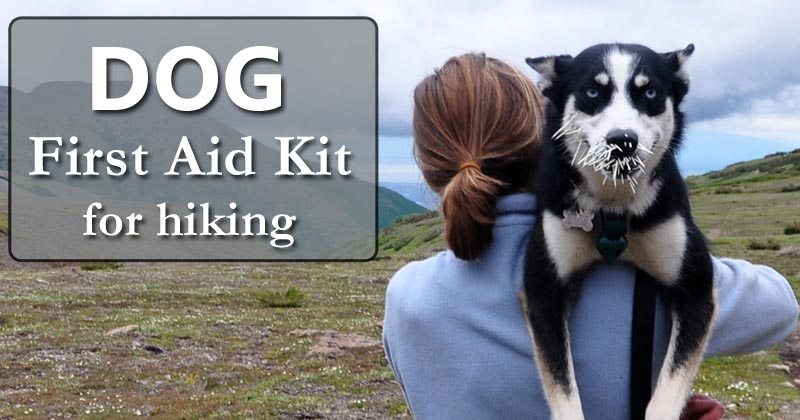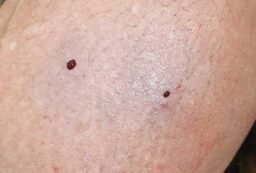Just like how you should always take a first aid kit with you hiking (here’s what’s in mine), you should have a first aid kit for your dog too. There is some crossover between the items, so you can combine your dog’s first aid kit with yours. Certain human first aid items are not suitable for dogs though, so you will need to pack canine-friendly meds and bandages.
Here’s a list of items to include in your dog first aid kit, why you need them, and how to use the supplies on the trail. Also read this post on Tips for Hiking with a Dog.
Why Your Dog Needs a First Aid Kit
Even though dogs tend to be more nimble than us humans, they can still succumb to the same injuries when hiking, backpacking, or camping: falling from heights, broken bones, sprained joints… Dogs are also more likely to be involved in animal attacks, and even small animals like marmots can do serious damage to your dog.
For this reason, you should always be prepared for the worst. That means bring first aid supplies to stop bleeding and bandage serious wounds.
On top of that, paw injuries are actually very common with dogs when hiking. Unless you want to carry your dog off the trail, absolutely make sure you have items for treating injured paws. That means bringing items like tweezers to remove thorns, skin glue to patch a torn paw pad, and bandages.
Note: Bandages don’t stay on dogs well because of all their hair. Dogs also have a tendency to chew on their bandages. This is why dogs require so many layers of bandages for injuries. Don’t skimp on the bandaging supplies!

This poor dog tore its paw pads hiking on hot ground. He kept chewing on the gauze bandages and the owners didn’t have VetWrap so they had to duct tape the bandages on.

Cleaning a torn paw after a hike. Paw injuries are common with dogs.
Dog First Aid Kit Checklist
1. Irrigation syringe and fluid
This is used to clean debris out of a wound. It can also be used as an eye wash. Choose a 10cc syringe with an 18 gauge tip.
2. Antiseptic Prep Pads
Use these to disinfect wounds before bandaging them to prevent infection. Povidone-iodine are preferred over alcohol pads because they don’t burn. You can also use liquid povidone-iodine, but it takes up more space.
3. Antibiotic Ointment
Antibiotic ointment serves two vital roles. First, it serves as a barrier and prevents the bandage from getting stuck to the wound. This is important because you don’t want the scab to tear off each time you change the bandage. Second, the ointment helps prevent infection.
Which ointment to use on dogs? Triple antibiotic ointments like Neosporin containing Bacitracin, neomycin, and polymyxin B are generally considered safe for dogs. However, you still want to make sure your dog doesn’t eat the ointment, so put lots of layers of bandages over the ointment.
4. Non-stick sterile gauze pads
After applying antibiotic ointment, you put a gauze pad over the wound. This will protect the wound and control the flow of blood. Your dog and you can use the same type of gauze pads for injures, but dogs will go through gauze faster (chewing on them, getting them dirty…) so bring extras.
5. Sterile gauze
After applying the pad, put sterile gauze on top. This provides another layer of protection against dirt. It also creates an extra barrier so your dog doesn’t chew at the wound.
What’s the difference is between a non-stick gauze pad and sterile gauze? A non-stick gauze pad is generally made from non-woven gauze whereas sterile gauze is woven. Non-woven gauze is more absorbent and less likely to leave lint in the wound. You could use sterile gauze as a primary bandage over a small wound, but it isn’t recommended for serious cuts.
6. Roller Bandage
Also known as a conforming gauze bandage, this is a long strip of gauze. It is used to hold the gauze pads in place. For broken or injured limbs, you can also use a roller bandage to immobilize a limb.
Starting about 1 inch below the gauze pad, wrap the roller bandage in a spiral around the injured area. Once you get about 1 inch above the injury site, start rolling the bandage downward so it overlaps. Keep rolling up and down, with each layer covering the previous layer by 50%. Make sure there aren’t any wrinkles in the bandage as these can cut off circulation.
7. Stretch gauze
This is a thin layer of bandage which is slightly elastic. Apply it just like a roller bandage. It’s important for holding the previous layers in place.
8. Self-Adhering Bandage (VetWrap)
VetWrap is an awesome bandage which can stick to itself but not other materials. Because it is elastic, it will apply some pressure to a wound, which is important to control bleeding, especially since dogs don’t always know to be careful with their injury.
I know a hiker who swears by VetWrap for humans. He even stopped carrying an Ace bandage in his first aid kit and uses VetWrap instead.
To apply VetWrap to a dog, wrap it in a spiral motion just like you did with the roller bandage. It shouldn’t be too tight; make sure you can fit a finger between the VetWrap and the bandages beneath it.
9. Plastic bag
In case your dog gets a serious injury while hiking, you will want to have a clean plastic bag ready. The bag goes over the bandaged wound to keep it clean and dry.
10. Triangle bandage
A triangle bandage can be used for bandaging head or eye injuries in dogs. You can also use a triangle bandage to create a muzzle for your dog. Even the nicest dogs can bite when in pain!
Note you can use the same triangle bandage as is in your human first aid kit, so there is no need to carry two of these.
11. Medical tape
Medical tape can be used to hold the bandages in place before putting on the next layer. They can also be used to make your own butterfly closures for deep-but-thin cuts, such as knife wounds. Your human first aid kit also needs medical tape, so you don’t need to carry two rolls of tape.
12. Tweezers
Tweezers are a must-have in a dog first aid kit. They are used for removing ticks, thorns, splinters, and debris from wounds. I recommend getting a tick removal tool which can also be used on humans. Then you and your dog can share.
13. Hydrogen Peroxide 3%
If your dog eats something poisonous while hiking, you can give it hydrogen peroxide to make it vomit.
14. Pain medications
Many of the pain medications for humans are dangerous for dogs, so do not give your dog OTC medications like ibuprofen, acetaminophen, or aspirin unless your vet says otherwise.
The following pain medications are safe for dogs, but you still need to check with your vet first and ask about dosage:
- Carprofen (Novox or Rimadyl)
- Deracoxib (Deramaxx)
- Firocoxib (Previcox)
- Meloxicam (Metacam)
*You might want to also bring a little vial of peanut butter to hide the pills in or a pill gun.
15. Skin glue
Torn and cut paws are one of the most common hiking injuries for dogs. Skin glue like Liquid Skin Bandage is great at closing paw wounds. Styptic pencils are another option for sealing small cuts. While I’ve never tried it, some dog owners swear that super glue works great, though others say it’s not conducive of wound healing.
16. Paw balm
If your dog isn’t used to hiking, it’s good practice to apply paw balm before the hike. On the hike, check its paws every few hours. If the paws seem dried out, worn, or are cracking, apply some more balm. Musher’s Secret is the most popular paw balm.
17. Hydrocortisone cream and/or antihistamines
Your dog might have a bad reaction to insect stings, poison ivy, nettles, or other plants. You can apply either a hydrocortisone cream directly or give your dog an antihistamine like diphenhydramine. Make sure you talk to your vet about which choice is better and the proper dosage.
18. Thermometer
Dogs can easily overheat while hiking, especially short-muzzled breeds. To play it safe, you can bring a digital thermometer to check your dog’s temperature. A dog’s normal temperature should be between 101 and 102.5F. Heat exhaustion occurs between 103 and 106F. If the temperature is above 106, your dog could succumb to heat stroke.
Best Premade Dog First Aid Kits
Instead of buying each of these dog first aid items individually, you can buy premade first aid kits for dogs. These are the two I would recommend for hiking, camping, or backpacking with your dog.
Adventure Medical Kits Trail Dog First Aid Kit
Adventure Medical Kits is one of the few companies to make comprehensive first aid kits specifically for travel and outdoor sports. I love their camping first aid kits, and their dog kit is just as good as the human kits. It has everything you need without a bunch of useless extras, so the kit is compact and fairly light. The kit weighs 12oz and contains a pet first aid field guide.
Buy here on Amazon or here on REI
Contains:
- Sterile Gauze Dressing, x2
- Sterile Non-Adherent Dressing, x2
- Conforming Gauze Bandage
- Irrigation Syringe
- Saline Wound & Eye Wash
- Elastic Bandage Self Adhering
- Triple Antibiotic Ointment, x3
- Antiseptic Wipes, x6
- Alcohol Swab, x2
- Triangular Bandage
- Tick/splinter Remover
- Hydrogen Peroxide 3%, 1 oz.
- Diphenhydramine 25 mg., x2
- Pet first aid manual
Resources for this article:
https://trupanion.com/pet-care/pain-relief-for-dogs
static/file/How_to_apply_a_bandage.pdfhttps://www.vitalitymedical.com/gauze.html
https://vcahospitals.com/know-your-pet/bandage-and-splint-care-in-dogs
Image credits:
“Alaska 2010 : Our first hike.” (CC BY-NC-ND 2.0) by PrettyKateMachine,
“Bella napping with crash workers in the” (CC BY-SA 2.0) by simonov
“Hurt Paw with Hydrogen Peroxide Wash” (CC BY 2.0) by OakleyOriginals













Post your comments